

Knowledge Quest: Collection Development Archives. School Library Connection. Intellectual freedom is an important issue that librarians face every day.
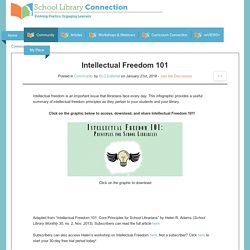
This infographic provides a useful summary of intellectual freedom principles as they pertain to your students and your library. Click on the graphic below to access, download, and share Intellectual Freedom 101! Adapted from “Intellectual Freedom 101: Core Principles for School Librarians” by Helen R. Adams (School Library Monthly 30, no. 2, Nov. 2013). Subscribers can read the full article here. Subscribers can also access Helen’s workshop on Intellectual Freedom here. Up to the Challenge: Dealing with school library book challenges before they happen. When I worked as a school librarian at Little Elementary in Arlington, Texas, I was terrified of having a book challenged.
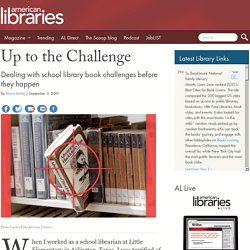
Sometimes I would wake up at night worrying. I was afraid a parent would be angry with me, and my principal would think I was a bad librarian. If you ever find yourself wide awake and troubled about possible challenges: Get out of bed, drink some water, and remember that you have nothing to fear—if you’re prepared before a complaint occurs. Build your foundation The first step is to be an excellent educator. The second step is to find the section in your district’s school library handbook on reconsideration of school library materials. The third step is to have a policy allowing all students the opportunity to come to the school library daily to check out books.
Real-world applications. Intellectual Freedom Blog - The Office for Intellectual Freedom of the American Library Association. *AASL Selection & Reconsideration Policy Toolkit. Toolkit Cover (Print Version) Since 1998, the American Library Association’s (ALA) Workbook for Selection Policy Writing has provided guidance to school librarians.
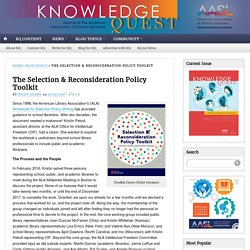
After two decades, the document needed a makeover! Kristin Pekoll, assistant director at the ALA Office for Intellectual Freedom (OIF), had a vision. *Position Statement on the Confidentiality of Library Records. The members of the American Library Association,* recognizing the right to privacy of library users, believe that records held in libraries which connect specific individuals with specific resources, programs or services, are confidential and not to be used for purposes other than routine record keeping: i.e., to maintain access to resources, to assure that resources are available to users who need them, to arrange facilities, to provide resources for the comfort and safety of patrons, or to accomplish the purposes of the program or service.
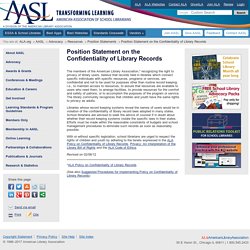
The library community recognizes that children and youth have the same rights to privacy as adults. Libraries whose record keeping systems reveal the names of users would be in violation of the confidentiality of library record laws adopted in many states. Bcpslis / Collection Development (Wiki of resources) Collection Development in the School Library. Does My Collection Reflect My Community. Updating My Collection via the Inspire Collection Development Grant. My library is beautiful.
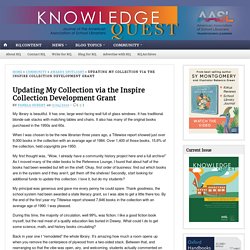
It has one, large west-facing wall full of glass windows. It has traditional blonde oak stacks with matching tables and chairs. It also has many of the original books purchased in the 1950s and 60s. When I was chosen to be the new librarian three years ago, a Titlewise report showed just over 9,000 books in the collection with an average age of 1984. Over 1,400 of those books, 15.6% of the collection, held copyrights pre-1950. My first thought was, “Wow, I already have a community history project here and a full archive!” Access to Print Books? Yes! In this time of virtual and hybrid learning, are print books still important?
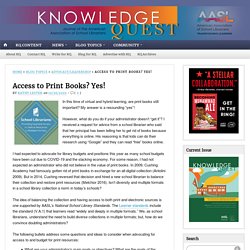
My answer is a resounding “yes”! However, what do you do if your administrator doesn’t “get it”? Library Privacy Guidelines for Students in K-12 Schools. Introduction Libraries face a number of challenges in protecting the privacy of users, especially students in elementary, middle, and high schools.
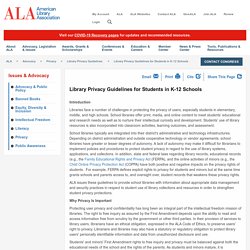
School libraries offer print, media, and online content to meet students’ educational and research needs as well as to nurture their intellectual curiosity and development. Students’ use of library resources is also incorporated into classroom activities, learning outcomes, and assessment. School libraries typically are integrated into their district's administrative and technology infrastructures. Depending on district administration and outside cooperative technology or vendor agreements, school libraries have greater or lesser degrees of autonomy. ELMS Classification System. AASL OER Toolkit. Webinars. The gardener’s hat. Wearing my volunteer’s hat, I am currently helping a colleague at a local school evaluate the collection and weeding all its sections in preparation for a major refurbishment later this year.
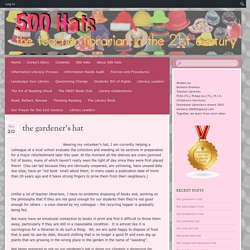
At the moment all the shelves are cram-jammed full of books, many of which haven’t really seen the light of day since they were first placed there! (You can tell because they are obviously unopened, are yellowing, have unused date due slips, have an “old book’ smell about them, in many cases a publication date of more than 20 years ago and it takes strong fingers to prise them from their neighbours.) Unlike a lot of teacher librarians, I have no problems disposing of books and, working on the philosophy that if they are not good enough for our students then they’re not good enough for others – a view shared by my colleague – the recycling hopper is gradually being fed. *Position Statement on Labeling Books with Reading Levels. The following position statement is currently under review to align with the National School Library Standards.
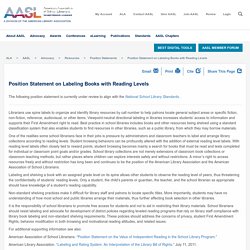
Librarians use spine labels to organize and identify library resources by call number to help patrons locate general subject areas or specific fiction, non-fiction, reference, audiovisual, or other items. Viewpoint-neutral directional labeling in libraries increases students’ access to information and supports their First Amendment right to read. Best practice in school libraries includes books and other resources being shelved using a standard classification system that also enables students to find resources in other libraries, such as a public library, from which they may borrow materials. One of the realities some school librarians face in their jobs is pressure by administrators and classroom teachers to label and arrange library collections according to reading levels.
A School Librarian's Thoughts on Labeling Programs: Part 1. A recent post in the Future Ready Librarians Facebook group on reading levels had me reflect upon my reading experience as a student.
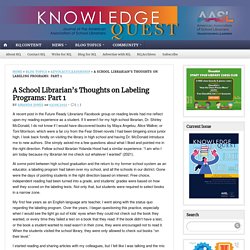
If it weren’t for my high school librarian, Dr. Shirley McDonald, I do not know if I would have discovered books by Maya Angelou, Alice Walker, or Toni Morrison, which were a far cry from the Fear Street novels I had been bingeing since junior high. I look back fondly on visiting the library in high school and having Dr. McDonald introduce me to new authors. She simply asked me a few questions about what I liked and pointed me in the right direction.
At some point between high school graduation and the return to my former school system as an educator, a labeling program had taken over my school, and all the schools in our district. My first few years as an English language arts teacher, I went along with the status quo regarding the labeling program. Collection Development: Meeting the Needs of Our Emerging Readers. A few years ago, when I began my current position as a school librarian, the most regular library users in my building were our CDC-A (Comprehensive Development Classroom – Activity Based) students. These students receive special education services that are designed for learners with deficits across the curriculum that are significantly below grade level. Teachers in this class emphasize not only academic success but social skills, self-help skills, advocacy skills, and life skills.
Our CDC-A students typically have severe disabilities that sometimes prohibit their communication or physical capabilities. Making the Most of Your Digital Collection. Diversity in Context: Stretching the Idea of Building Diverse Collections. Presented by Michelle Luhtala, Library Department Chair, New Canaan High School, CT; Robert Hillhouse, Secondary Multilingual Programs Teacher on Special Assignment; and Kerrin Moeller, Elementary Multilingual Programs Teacher on Special Assignment Sponsored by Mackin Educational Resources Get a CE Certificate for this edWebinar Learn more Our inquiry series continues as we take a deep dive into building a diverse collection and nurturing a community of curious readers.
As reader advisors, we know that young readers often relate to characters who share some of their own characteristics. The popularity of the realism genre encourages the publishing industry to pair representative characters with stories that feature headline-worthy drama. This edWebinar will be of interest to K-12 librarians, teachers, and administrators. *Dawkins The Decision by School Librarians to Self Censor .pdf. Multicultural Picture Books: A Deeper Look at Your Collection Webinar. Series Tracker — Perma-Bound Books. Shelf Awareness. Controlled digital lending and Open Libraries: helping libraries and readers in times of crisis. Tldr; As libraries face closure across the globe because of coronavirus, millions of digitized books are now available for free to be borrowed by learn-at-home students and readers.
We need more libraries to join Open Libraries to offer more copies to patrons; its free and easy. In response to the global COVID-19 outbreak and related public health concerns, libraries across the nation are closing or scaling back service (see Fremont, Nebraska’s Keene Memorial Library closure; Seattle Public Library’s reduction in programs and bookmobile service).
While Overdrive, Hoopla, and other streaming services provide patrons access to latest best sellers and popular titles, the long tail of reading and research materials available deep within a library’s print collection are often not available through these large commercial services. That’s where the Internet Archive’s Open Libraries program, powered by controlled digital lending, can help. We are ready to assist however we can. Learn How We Categorize Multicultural Picture Books. We have identified nine unique book categories that capture the dominant messages conveyed by current children’s picture books featuring Black and Indigenous People and People of Color (BIPOC). Each book in our collection is tagged with at least one category. Anyone can use our book categories to consider how BIPOC are represented in a story to ensure that no single message dominates bookshelves.
YALSA Book Finder. Ten Steps to Creating a Selection Policy that Matters. By April M. Dawkins • October 2018 Have you ever gotten a surprise package of books in your library that included a note saying, "For your collection"? At first, you're excited that someone sent you free books, but upon closer examination you begin to question if it would be a good idea to add the donation to the collection at all. Just as you ask your students to examine sources of information they want to include in their research projects, you should be asking questions about donations, especially if they are unsolicited ones. The Statistical and Philosophical Art behind Elegant Collection Management. Collection management and balance previously (here is where I give away my age) meant making sure your fiction titles were no more than 20 percent of the collection and that you weeded and brought in new material for your students and teachers.
Today, the complexities of managing library collections has been both energized and compounded by the 21st century environment of multiple formats, learning styles, abilities, and cultures. Can I Buy Half of a Subscription Database? Beginning with a disclaimer is probably the best way to start off an article about the rising cost of subscription databases. I realize in writing this article many of my peers have no district budgetary support for subscription databases. I heavily debated sharing my thoughts, yet in the end, I decided this subject was too important. What's in Your Library's "Things" Collection? The new book Audio Recorders to Zucchini Seeds: Building a Library of Things, edited by Mark Robison and Lindley Shedd explores the growing practice of circulating "things collections" in libraries.
These collections include items such as tools, toys, seeds, and something that school librarians may circulate already—curricular materials—all available for patrons to check out and use outside the library. METIS - School Library Cataloging. The Metis Library Classification System by Elissa Freda. Genrefying Your Collection WITHOUT Changing Call Numbers (ibrarygirl) Genrefying Your Collection Without Changing Call Numbers. Every Standard Tells a Story: School Library Curate. *Intellectual Freedom.
Workbook for Selection Policy Writing. Weeding Library Collections: A Selected Annotated Bibliography for Library Collection Evaluation. "Next to emptying the outdoor bookdrop on cold and snowy days, weeding is the most undesirable job in the library. It is also one of the most important. Collections that go unweeded tend to be cluttered, unattractive, and unreliable informational resources. " - Will Manley, "The Manley Arts," Booklist, March 1, 1996, p. 1108. *Position Statement on Digital Content and E-books in School Library Collections. Today’s twenty-first century students must be able to discover, analyze, evaluate, interpret, and communicate ideas, information and knowledge in a variety of ways.
Learning to Work with Vendors. Titlewave is the Best Tool for IB Educators. If You Order It, They Will Read It! *(Scan)Selection & Reconsideration Policy Toolkit for Public, School, & Academic Libraries. Introduction to Genrefication. Setting up Biblionasium in Destiny Discover. Andy Plemmons (Expect the Miraculous) *Reintroducing Printed Books to the Cushing Academy Library (MSLA Forum Newsletter) *Collection Development - NYC School Librarian Guidebook. Let's Talk Collection Development! School Library Collection Development. Leading Against Censorship: An Interview with Librarian Lynn Evarts - Intellectual Freedom Blog. Workbook for Selection Policy Writing. Collections by Destiny.
Incombustible Ideas: The Subtle Bigotry of Book Banning by Jennifer LaGarde and Travis Crowder. Three Cool Tools for Collection Development. Follett Book Processing & Cataloging Specifications. Defending Intellectual Freedom: LGBTQ+ Materials in School Libraries - National School Library Standards. Specifications. No Money for Books? Start a Birthday Book Club! Libraries of Things. Collection Development Archives (scan for relevant new content) Sample Collection Policy. Digital School Library Leaves Book Stacks Behind. Thinking Outside the Bin: Why labeling books by reading level disempowers young readers. BFTP: Keeping Your Library Collection Smelling F.R.E.S.H! (Jennifer Lagarde) *CREW: A Weeding Manual for Modern Libraries. How to Weed by the Numbers and Clean Up Your Collection.
Non Fiction Weeding - The Visual Guide by Dianne. ‘Weed in the dead of night’: A librarian shares the secrets of book-culling. Weeding Without Controversy through inclusion and transparency. School Libraries in Music City: Why would a librarian get rid of books?! CREW Weeding Guidelines. ON LIBRARIES – Weeding and Leading. Culling Your Collection: The Fine Art of Weeding. Collection Management. Weeding without Worry. Fiction Genrefication at the Elementary School Level. School Library Journal. Ditching Dewey? These Ideas Can Get You Started on Genrefication.
Genrefication: Removing Barriers to Access. Are Dewey’s Days Numbered?: Libraries Nationwide Are Ditching the Old Classification System. KNOW_42_2_OE_DeweyDo.pdf. Ditching Dewey: Making the Move. Ditching Dewey (on genrefication)